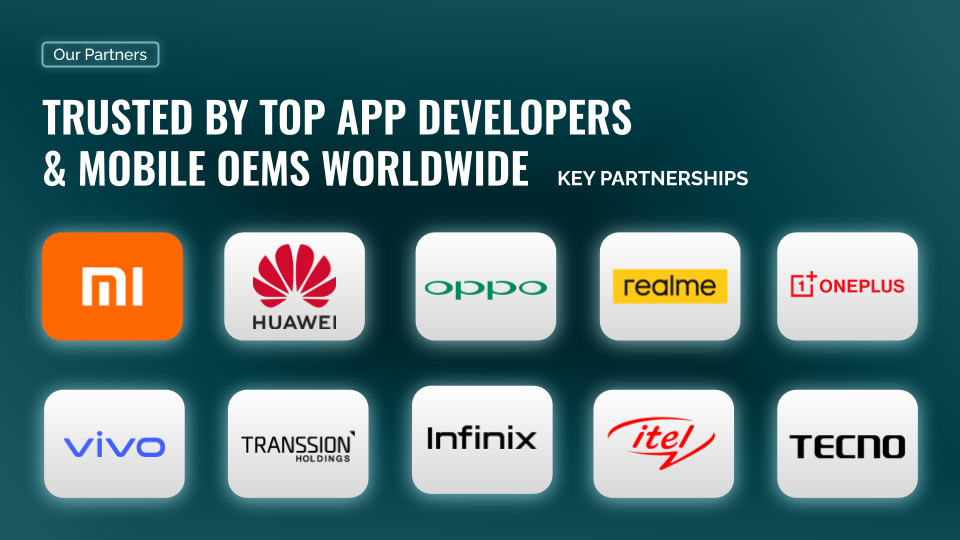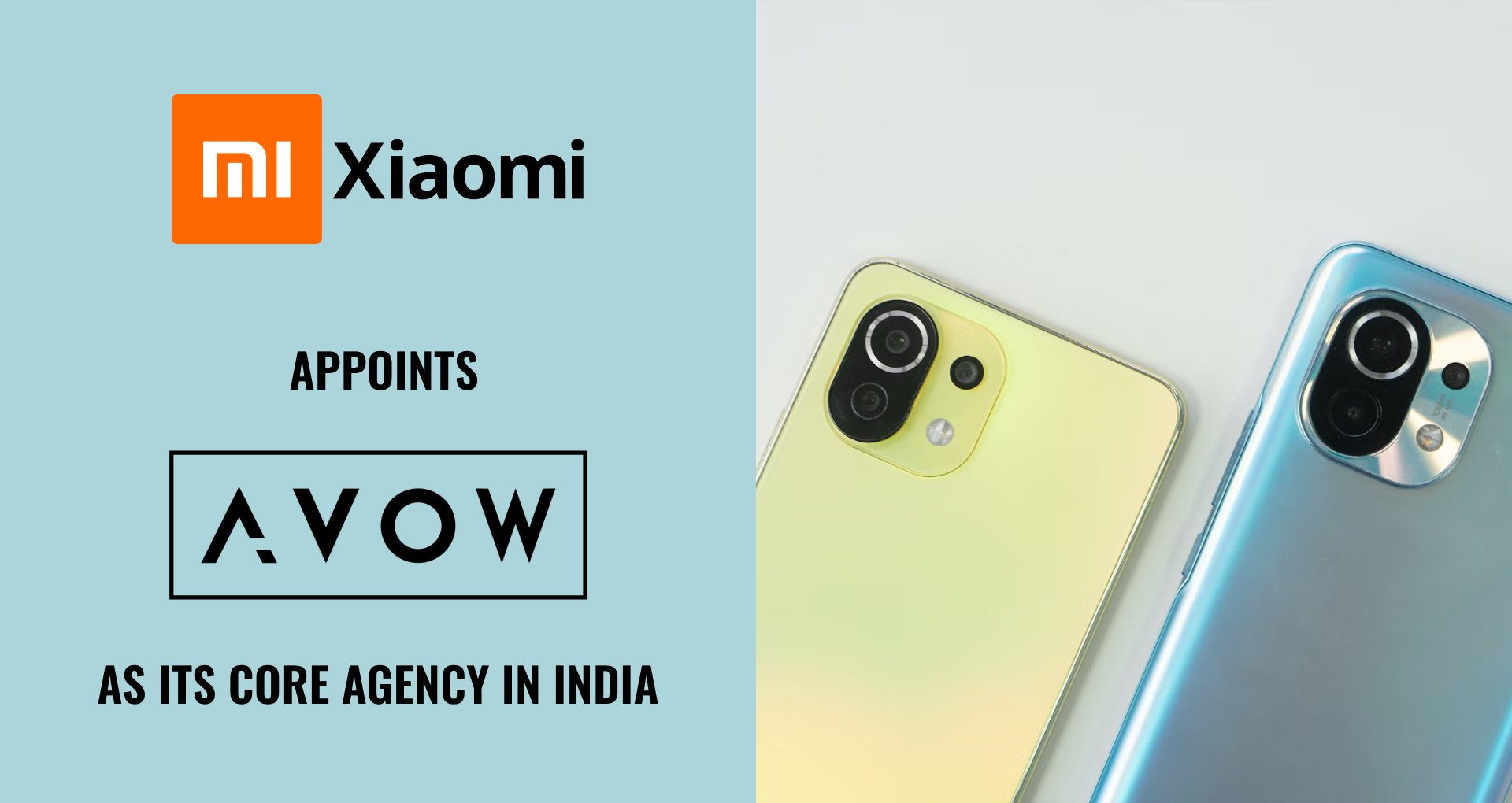Discover AVOW: Revolutionizing Mobile OEM Advertising
AVOW: At the Forefront of Mobile Innovation
AVOW is not just another player in the mobile advertising arena; it's a trailblazer, an award-winning global app growth company dedicated to revolutionizing mobile OEM advertising. With a robust roster of over 100 advertisers, AVOW leverages its proprietary technology AVOW Intelligence to offer unprecedented access to over 1.5 billion daily active users. This capability translates into over 10 million monthly downloads for our clients, marking us as an industry leader poised to push the boundaries of mobile advertising. Needless to say that we have key partnerships with all premium mobile OEMs globally.
Why AVOW Stands Apart
AVOW’s uniqueness lies in its pioneering role in Mobile OEM on-device advertising, offering access to user audiences beyond the reach of traditional networks. Our focus extends beyond the Apple App Store and Google Play Store, venturing into alternative app stores and platforms. This strategy not only differentiates us but also positions our clients to capture a significant share of the global mobile market, which is increasingly dominated by mobile OEMs and alternative app stores.
Our Journey: From Concept to Global Leader
Established in March 2018, AVOW was born out of a shared vision by a founding team with a rich history of collaboration. Recognizing the mobile industry's dynamic nature, we sought to introduce a disruptive solution that would redefine the ecosystem. Easy to say but hard to find - During that period, Google had clashed with Huawei, while Fortnite had clashed with Google and Apple. Suddenly, the direction we needed to take was clear: alternative app stores and mobile OEMs.
Pro Tip: Stay up to date with everything mobile OEM and AVOW related by following us on Linkedin.
AVOW's Awards and Recognitions from Mobile OEM Partners
Discover the latest accolades and partnerships that underscore AVOW's leadership and commitment to excellence within the mobile OEM advertising:
- 2024 Global Core Agency by Xiaomi MiAds: AVOW has been honored with the title of the Global Core Agency by Xiaomi MiAds, solidifying our standing as a premier partner in the industry. Read More
- Strategic Partnership with Huawei: AVOW's strategic collaboration with Huawei signifies our dedication to innovation and expansive reach within the mobile advertising landscape. Read More
- Global Core Partner Role with Vivo: AVOW's pivotal role as a global core partner with Vivo in Southeast Asia showcases our deepening connections and influence in vital markets. Read More
- Global Top 3 in AppsFlyer Performance Index Finance Category: AVOW's outstanding performance in the AppsFlyer Performance Index Finance Category places us among the global elite, reaffirming our commitment to excellence. Read More
- Strategic Core Partner with OPPO: AVOW's strategic alignment with OPPO as a core partner in the Philippines and Vietnam elevates our presence and impact in mobile advertising. Read More
- Gold Agency Distinction With Transsion In Indonesia: AVOW's attainment of Gold Agency Distinction with Transsion in Indonesia underscores our commitment to excellence and our growing influence in the region. Read More
- AppsFlyer Premier Solutions Partner for 2023: AVOW's recognition as an AppsFlyer Premier Solutions Partner for 2023 highlights our dedication to innovation and performance excellence. Read More
Global Reach, Local Expertise
AVOW’s global operations span across continents, with a dedicated team that brings local expertise to every market. From Europe, SEA to the US, our local mobile experts understand the nuances and opportunities unique to their regions, ensuring tailored and effective strategies.
The Essence of AVOW: Commitment and Transparency
The name AVOW reflects the essence of our mission: to affirm or commit to our clients and services with openness and integrity. This principle is the foundation of our company philosophy, ensuring a fully transparent and dedicated approach in all our operations. It’s a commitment that not only defines us but also sets the standard for excellence in the industry.
Beyond the tech and tools, our company is powered by PEOPLE. We are a community of veteran digital marketers and techies committed to enhancing your value to the app economy. AVOW´s philosophy lies in people-powered technology: our team questions, invests, and aims for growth facilitated by our in-house tools. Our team of experts, of over 31 nationalities, manages a range of over 100 brands, simultaneously promoting their apps across 10 major OEMs from 12 cities globally.
Diversity: More Than Just a Buzzword at AVOW
At AVOW, diversity is embedded in our DNA, not merely as a concept but as a living, breathing aspect of our daily operations. Our management team, boasting varied origins from India to Brazil, Bolivia to Russia, France, and Germany, epitomizes our commitment to a multicultural, inclusive workplace.This rich tapestry of backgrounds fosters an innovative and open-minded workplace where everyone is encouraged to bring their authentic selves.
The AVOW Highlight in 2023
In the summer of 2023, AVOW celebrated a milestone that encapsulated the essence of our vibrant and innovative culture: our first global retreat in Berlin. This event brought together the A-team, our dedicated members from around the world, for an unforgettable week of collaboration, learning, and exploration. The retreat was a perfect blend of work and play, offering ample opportunities for networking, skill enhancement, and team building. Participants dove deep into the heart of Berlin, experiencing the city's renowned nightlife and the unique vibe that makes it so special. This gathering was more than just a team-building exercise; it was a testament to AVOW's commitment to fostering a close-knit community that thrives on creativity, diversity, and mutual respect, truly showcasing the spirit and unity of the A-team.
More pictures from our AVOW Retreat
Get to Know Us
Becoming a part of our team will be through a swift and impactful recruitment process because we respect your time and energy! There’ll be 4 key steps - ensuring clarity and efficiency at each of these.
👋🏼 Initial contact - Our process begins with a casual yet informative screening call with our TA team. This initial touchpoint allows us to learn more about you and provides you with a glimpse into our team and culture!
🤝🏼Deep dive - In this phase, you'll have a more in-depth discussion with our hiring manager. It's an opportunity to explore the role deeper and have a better sense for the expectations.
🧠 Analytical task + presentation - This stage will be all about highlighting your unique strengths and problem-solving skills while allowing you to get more insights into the team and its current challenges.
🔚 Informal chat - An optional round to allow you to meet a potential team member.
And that’s about it! We're on the lookout for folks who aren't just fitting but rather adding more to our organizational culture and values.
Ready to explore a role with us? Send us your application!
Did you know? AVOW HQ is located in the middle of buzzing Kreuzberg - Oranienstr, which was named as one of the coolest streets in the world in 2024 by Time Out Magazine.
Joining the AVOW Team
Whether you're an advertiser looking to explore untapped markets or a professional eager to contribute to the future of mobile advertising, AVOW offers a landscape of opportunities. Our unique approach, combined with a commitment to innovation and transparency, makes AVOW not just a workplace but a ground for pioneering solutions in mobile advertising. Employee benefits like sport and fitness memberships, transport discounts, language classes, an extra day off for your birthday, and barista-style coffees underscore AVOW's dedication to the team's well-being and professional growth.
We invite you to be part of this exciting journey, as we continue to redefine the boundaries and possibilities of the mobile ecosystem.
Looking ahead, we envision a future where Mobile OEMs are integral to every marketer's media plan, establishing AVOW as the definitive partner for all Mobile OEM-related endeavors.
Are you interested in joining our team? Have a look at our open roles
Bolster Your User Acquisition Strategy by Incorporating a Dynamic Preloads Campaign via OEM advertising
The Smartphone industry in India is projected to grow by 7.20% in the next five years, with a resulting market volume of 234.50 million units, amounting to US$59.08 billion by 2028. This can be attributed to multiple factors, such as an increase in disposable income, a strongly associated socio-economic status and rapid innovation chief amongst them. In 2024, the segment is expected to grow by 5.9%. (Source: Statista). It thus comes as no surprise that mobile advertising spending is expected to reach 78% of the total digital marketing expenditure by 2023. (Source: Statista). In April 2023, the Original Equipment Manufacturers (OEMs) currently led by Xiaomi, closely followed by Vivo, Oppo, Realme, OnePlus and others occupied approximately 80.42% of the smartphone market share in India. (Source: Statcounter). This opens up a big opportunity for app developers to utilize mobile OEM advertising and in particular the option of Dynamic Preloads campaigns, for apps and brands looking at maximizing their mobile marketing campaigns against the backdrop of a highly competitive and saturated market.
Dynamic Preloads presents a highly targeted on-device customer acquisition channel wherein brands collaborate with OEMs, with device manufacturers dynamically prompting users to download their app upon activation of new devices. Dynamic preloads ensure a smooth user journey, from prompt to app download, significantly increasing app awareness and download rates.
What makes Dynamic Preloads a promising channel to leverage by app marketers.
Scalability and Targetability: India is the second largest smartphone market, with 2022 seeing smartphone shipments reaching 144.3 million units. With the mobile industry innovating at an unprecedented rate, app marketers should turn to dynamic preloads, as it provides access to focused and strategic targeting of this huge prospective user base.
Measurable and Optimizable: The effectiveness of Dynamic Preloads can be accurately gauged with mobile attribution KPIs providing the value of each channel, mapping the user journey, and drawing actionable insights based on demographics, geo-location,. Additionally, Dynamic Preloads allow for quicker turnaround from app launch to app discovery, as apps can be discovered by the user as part of a Dynamic Preloads campaign, making for a quicker turnaround as compared to discovering an app organically.
Relatively Lower CAC and positive ROAS: Marketers are always hustling to reduce the overall customer acquisition costs (CAC) for their brand campaigns. Strategically approaching and optimizing Dynamic Preloads on various OEMs can ensure an overall low CAC and a positive return on advertising spend (ROAS).
Dynamic Preloads allow advertisers to pay for Cost per Install (CPI) allowing advertisers to secure CPI prices at a lower cost, shielding them from the fluctuating prices borne out of seasonality, more commonly seen in display ad pricing from traditional providers such as Google and Facebook. making it essential for marketers to align their focus to an ecosystem that has grown more agile, quick, flexible, and affordable with the arrival of dynamic preloads.
User Choice: Unlike Traditional Preloads, Dynamic Preloads work through user consent, as users would have to opt-in to downloading the app. This makes every install of the app very deliberate and moves away from the model of forcing an app onto a user without their consent, more typically known as bloatware.
Up-to-date: Unlike Traditional Preloads where the app is preinstalled months before the phone hits store shelves, Dynamic Preloads only downloads the latest version of the app upon user consent, ensuring that the user is interacting with the latest version of the app
Improves Organic Ranking: A surprising yet welcome side-effect of using Dynamic Preloads is the fact that an apps’ organic ranking can be elevated, as the nature of this solution requires the app to be downloaded directly from the Google Play Store, thus affecting the Play Store numbers.
First Mover Advantage: Being the first app in a particular app category allows users to discover the app faster. This can translate to loyalty to the app if the users now convert to using the app.
Incorporating a Dynamic Preloads campaign into your user acquisition strategy
- Set attainable goals and a realistic budget: Realistic goal setting is key to strategizing any user acquisition campaign. Set a definite install target based on the specifics of the target audience and reach capabilities of various channels in the marketing mix. Based on the industry average CAC for a particular OEM, marketers can zero in on the required budget based on their goals and targets. An additional factor that also needs to be considered while setting up targets and budgets, is the minimum per-day download threshold set by different OEMs.
- Select OEMs and devices carefully: Conduct research on which OEMs are widely used by the brand’s target audience, together with the app’s organic performance on the different app stores. A marketer can then select a combination of OEMs and devices it would like to run their Dynamic Preloads campaign. These factors would also help determine budget distribution amongst various OEMs.
- Attribute Installs to Dynamic Preloads/Pre-Install campaigns: With the help of the right mobile measurement partner (MMP), brands should strategise and continually monitor the performance of their campaign across different OEM advertising channels by tracking downloads and engagement levels both pre and post app installation.
- Setting the Right Attribution Window: To measure the optimal quality of your preload campaign, it is essential to set the right attribution window. There are often delays between launching the campaign and seeing any user action, and as such a short attribution window could lead to misattribution or seeing no results in the campaign at all. Thus, the minimum recommended window should be set at 60 days.
- Measure the Results and Optimize: Tracking data and analyzing insights will help in understanding campaign shortfalls and allow for optimization by improving placements and creatives or redirecting resources towards better performing segments, locations or devices. Ongoing monitoring and the right optimizations will lead to a greater ROI
- Take an integrated marketing approach: Though a particular channel might perform better than another, it is essential to take an integrated marketing approach encompassing various channels, to maximize paid as well as organic results.
The projected statistics and capabilities of Mobile OEMs clearly state the importance of utilizing these alternative app stores to reach high-quality untapped users at scale. To stay on top of their game, advertisers and marketers should leverage this channel’s potential by strategically incorporating Dynamic Preloads in their mobile marketing mix. Expert agencies such as AVOW that have close partnerships with Smartphone OEMs can help brands and app developers by providing them greater visibility and the opportunity to become a ‘go-to’ app for new users. These agencies not only effectively assist marketers in reaching their user acquisition goals but also help them launch their apps on different mobile OEMs with specific geo-targeting for the selected markets.
Want to learn more about how Dynamic Preloads can work for you? Contact us to find out more!
Xiaomi MiAds Appoints AVOW as its Core Agency in India
AVOW, the specialist in mobile OEM on-device user acquisition, has been appointed by Xiaomi MiAds, a leading mobile Original Equipment Manufacturer (OEM), as its official core agency of user growth and customer success solutions in India.
This partnership empowers app developers and brands looking to use mobile OEM advertisement to achieve incremental growth by making inroads into Xiaomi's massive loyal user base through AVOW in the world’s most populous country. Furthermore, this cooperation adds India as the 4th key region represented by AVOW, making the firm the only agency worldwide to represent Xiaomi MiAds in four areas, which also includes EMEA, SEA, and LATAM, at once.
AVOW stood out for its exceptional undertaking of media business activities and exemplary customer service for Xiaomi's Ad Platform (Mi Ads) in India and other markets. AVOW will operate as one of the main point of contact, managing a 360- degree execution of mobile advertising campaigns on Xiaomi's Ad Platform - from launching apps on GetApps marketplace, and booking dynamic preload campaigns to, media buying and campaign optimization.
"We are thrilled to be named the core agency again for Xiaomi. Building on our success in EMEA, SEA, and LATAM, our key partnership with Xiaomi MiAds extends to India. Strengthening our alliances will allow us to offer more exclusive opportunities for mobile marketers to access Xiaomi's strong presence in the country. India is a dynamic market, and we are committed to helping marketers with greater access to the untapped user audience and eventually make mobile OEM advertising a default part of every marketers' marketing mix", says Ashwin Shekhar, Co-founder, and CRO of AVOW.
MiAds is Xiaomi’s global advertising platform, which is one of the core services of Xiaomi’s international internet business. MiAds covers 100+ markets worldwide, is supported in 70 languages, and offers reach to 420 million+ quality monthly active users worldwide excluding mainland China. The platform provides a multi-faceted advertising portal through proprietary apps like Mi Browser, Mi Music, Themes, Mi Video, and its official proprietary app store GetApps. In addition, Xiaomi allows marketers to accurately locate target audiences and convert their users into brand's customers through multiple targeting options.
Sharing his views on this association, Bono Wu, Head of Channel Partnership & Direct Sales of EU and LATAM, International Internet Business Department, Xiaomi, said, "We are glad to have AVOW onboard as our core agency in India. AVOW's exceptional work in the Indian market and beyond has led us to continue our fruitful partnership. The combination of Xiaomi’s system-level empowerment to MiAds on MIUI and AVOW's deep expertise will be truly beneficial to our mutual clients.”
AVOW has established a strong market presence by collaborating with leading Indian brands like Amazon Prime, Unacademy, UpGrad, Byju's, MoneyTap, Avail, and WazirX. With its headquarters in Berlin (Germany), AVOW has expanded and strengthened its global presence by opening offices in India, Indonesia, China, Vietnam, Brazil, the Philippines, France, Spain to serve its sizable clientele in those markets. In 2022, AVOW was ranked and recognized for the 6th time in AppsFlyer's Performance Index. Combining expert knowledge with AVOW AI, their proprietary tech solution, AVOW fosters smart media buying and targeting, allowing clients to reach their user acquisition KPIs and goals.
Come talk to our team in India to find out how we can help you scale your app with Xiaomi.
Weathering the Tracking Storm in this New Normal with Mobile OEM Advertising: A Primer for Mobile Marketers
It’s been 18 months since Apple rolled out its App Tracking Transparency (ATT) framework, mandating iOS apps to ask user permission to track activity across apps and websites. The update has had a profound impact on the wider advertising industry, meaning brands can no longer ensure the accuracy of their targeting or see the true impact of what they are spending. As a result, according to the Wall Street Journal, nearly 50% of eCommerce advertisers polled had decreased spend on Facebook by more than 25%. More broadly, data suggests that Apple’s updates have also led to a 40% reduction in the average mobile marketer’s ROI.
With advertisers spending less on these platforms, some have also attributed GAFA’s drop in stock prices and slowing revenue growth to these new privacy changes. Mobile industry thought leader, Eric Seufert, has even gone so far as to say that the new privacy headwinds, along with consumer preference changes, has created a “recession within the social media advertising economy”. But how big is the true impact of the tracking storm - and how can mobile marketers survive it?
A safe bet to shift ad spend to Android?
Many advertisers have dealt with the ATT fallout by redirecting ad budgets to Android instead, where they can still benefit from user-level data. In fact, recent data shows that as much as 59% of US and UK marketers are increasing spend on Android, while decreasing what they spend on iOS.
But those marketers putting all their eggs in the Android basket should be on the lookout. Google is set to follow in Apple’s lead, after a recent announcement that it will remove access to Google Advertising ID. This is an ID generated by Android for a device, which is used for attribution, segmentation, and personalization - meaning running and optimizing campaigns will soon be as tricky on Android as they currently are on Apple.
Alternative app stores as part of your marketing mix
Luckily, there is an alternative to Apple and Android’s duopoly. Mobile Original Equipment Manufacturers (OEMs) are becoming an increasingly popular option for marketers who have reached a plateau advertising on GAFA, or who are unwilling to sink further ad spend into these channels. OEMs include the likes of Xiaomi, Vivo, Samsung, Oppo - and according to consultancy IDC, these four companies made up over 50% of global handset shipments in Q2 of 2022. These OEMs run their own dedicated app stores, called alternative app stores, where they can directly distribute applications to their customers - and brands can benefit from running effective, targeted ad campaigns.
This is because OEMs have their own advertising ID, called Open Anonymous Device Identifier (OAID). OAIDs aren’t subject to the same privacy regulations as Apple and Android, meaning marketers can still run deterministic tracked campaigns. Beyond the targeting capabilities, OEMs also offer a wealth of quality, untapped users at lower prices, all in a fraud-free environment. This cost effectiveness is one of the biggest benefits of working with OEMs, particularly in the current economic climate. Forget cost-per-click models – with mobile OEMs, advertisers only pay for installs.
Think mobile OEMs still form a niche market?
Think again: the industry has expanded rapidly over the last few years, with many mobile OEMs becoming the device of choice for consumers across APAC and western markets alike. Samsung is now the most popular smartphone brand in Europe overall, with a 32% market share, with Xiaomi and Oppo coming in third and fourth place respectively. Xiaomi is the most popular smartphone brand in Spain, with a market share of 28.5%. Don’t forget about Vivo and OPPO either: both are heavily investing in branding to strengthen their position. Vivo was one of the main sponsors of last year’s World Cup and the UEFA Euro 2020, while OPPO has sponsored the UEFA Champions League.
Mobile OEM users also tend to be highly-engaged and willing to open their wallets: in 2021, revenues for third-party stores averaged $36 compared to Google Play’s $42. As adoption of mobile OEMs continues to grow, it’s never been a better time to add alternative app stores to your marketing mix. A new competition law from the European Union has also forced Apple to allow alternative app stores on its iPhones and iPads, due to come into effect in 2024. Similar moves can be witnessed on Android where brand new devices from OEMs recently get shipped by default with the OEMs native app store. By opening their systems to competitors, brands can avoid Apple and Google’s gatekeeping while continuing to reach their growth goals.
Would you like to learn more about how AVOW can help you weather the tracking storm with Mobile OEMs? Then contact us now to find out more!
What is the EU Digital Markets Act? How New Regulations are Set to Dramatically Impact the Mobile OEM Advertising Landscape
2022 was the year we started to address big tech’s monopoly seriously. While industry leaders have criticized these companies’ anti-competitive behavior for years, it wasn’t until recently that new regulations, lawsuits and investigations have forced them to comply.
Among these is the EU Digital Markets Act (DMA), which was passed in spring of 2022. The landmark regulation targets digital gatekeepers, mandating they conduct their business in a fair and non-discriminatory way. Many of its policies are aimed specifically at the mobile ecosystem, ensuring competition between digital companies and breaking down Apple and Google’s grip on the mobile ecosystem.
Before proceeding further, it is important to understand what and who mobile OEMs are, and the role that the DMA would and would not play in their business moving forward. Mobile OEMs, such as Xiaomi, Huawei, OPPO, and Vivo are mobile Original Equipment Manufacturers (OEM). These companies will not be significantly impacted by the DMA from a hardware business perspective. However, the DMA will cause these OEMs to focus even more on building their own app ecosystem.
The DMA will lead to the end of Google and Apple's monopoly, with phone manufacturers gaining more control over their advertising formats and search functions. Each phone manufacturer already has its own app store, but it was previously a challenge to install them as the default app store on their devices. Google unofficially abused its market power, discouraging OEMs from investing resources in building their own app ecosystems.
The DMA disrupts the current status quo, offering alternatives and promoting competition, resulting in greater freedom for app developers and less risk. In the past, if Google removed an app from their store, it meant the potential end for the developer, who would essentially be pushed out of the market.. With more competition however, developers can rely on alternative app stores and avoid such a risk.
In short, it means that:
- Apple and Google are set to allow alternative stores on their devices from late 2023, or face fines of up to 10% of their annual global revenue
- The new legislation is set to be a boon for developers, who may no longer need to sacrifice a 30% cut of all in-app purchases currently made in the Apple and Google Play Store. Whilst OEM alternative app stores still take a cut, they are much more flexible and open to negotiations, unlike the rigid and unwavering app store policies of Apple and Google.
- Calls from industry leaders around the world is set to further increase the adoption of mobile OEMs among developers and consumers alike
The Apple and Google monopoly: The beginning of the end?
To better understand Apple and Google’s dominance, we need to go back to the advent of the App and Google Play Store over 15 years ago. From the start, both companies implemented a 30% cut on all in-app purchases made within their app stores. They also prohibited any third-party billing processing for apps looking to sidestep these fees. This has been one of the primary drivers of growth for both companies in recent years, but has had a real impact on app developers’ profits.
Three years ago, game developer Epic Games sued both Apple and Google for taking such a large cut of their sales. Other industry leaders, including Facebook and Spotify, have also spoken out against the fees. Among growing resentment from companies and consumers alike against big tech, it was time for regulators to step in.
Enforcement of the European Union's DMA is expected to begin in mid-2024, and the big gatekeepers, as the law refers to them, face fines of up to 10% of annual global revenue for violations. Apple and Google have already outlined how they will comply with the EU’s new competition laws: in Apple’s case, the company is now preparing to allow alternative app stores on its iPhones and iPads from late-2023. Google will be required to do the same, meaning users can install apps away from the companies’ App and Google Play Store. However it is important to note that unlike Apple’s walled garden approach, which outright forbade alternative app stores, Google used their position as a market leader to gatekeep and essentially handicap mobile OEMs and their alternative app stores. Google did this by:
- Not allowing alternative app stores on the Google Play Store
- Not allowing alternative app stores to be preinstalled on their phones
- Preventing the search bar present on the Android home screen to be used by Mobile OEMs for their own commercial use
Neither company has yet outlined plans on how they will integrate alternative payment systems, but it’s clear that developers - and the law - will no longer tolerate app stores taking such big cuts of their profits.
Opening the gates to mobile OEMs
With the enforcement of the DMA, we can expect a huge increase in the adoption of alternative appstores - both by developers and consumers - in the next few years. Xiaomi is currently fast tracking it’s plan to roll out Xiaomis GetApps store world wide. By end of Q2 Xiaomi’s GetApps will be rolled out to all EU geos, by EOY world wide.
The legislation is a huge boon for users, who will be able to benefit from more choice and lower prices. Developers will have newfound freedom of choice, making it far easier to launch, scale and profit from their apps. While the regulation remains only EU-wide so far, mobile thought leader John Koetsier suggested that the Digital Markets Act could well “break the App Store model”. He also mentions that “while it may take years to establish trust and brand awareness [in mobile OEMs, eventually they will constitute a viable alternative to the platform defaults.”
However, as alternative app stores gain more traction within Europe, it’s expected that mobile OEMs will also change their billing solutions. This could mean either making their proprietary payment models mandatory, or continue allowing the use of third-party payment solutions in return for a smaller revenue share.
There are already calls from industry leaders to extend the regulation beyond the confines of the European Union. Epic Games CEO Tim Sweeney showed support for the policy, tweeting that U.S. Congress should pass proposed legislation similar to DMA, or it "would leave American developers in serfdom”. India's Competition Commission recently announced it was fining Google $161.5 million for abusing its dominant position in multiple markets in the Android ecosystem and ordered the company to open it up to competition. South Korea passed a law that would force Apple and Google to allow developers to use third-party payment platforms, and in Japan, Apple had to agree to a major change in policy to end an investigation.
With increasing pressure facing both companies, it’s clear that the new laws will significantly impact adoption of mobile OEMs - meaning it’s never been a better time to integrate alternative app stores into your marketing mix. There is a wealth of opportunity for marketers who tap the vast distribution opportunities offered by alternative app stores, and it’s only set to get bigger in the years to come.
Want to learn more about what this could mean for you and your app? Want to unlock an untapped audience and reach new scaling heights? Then contact us to find out more!





